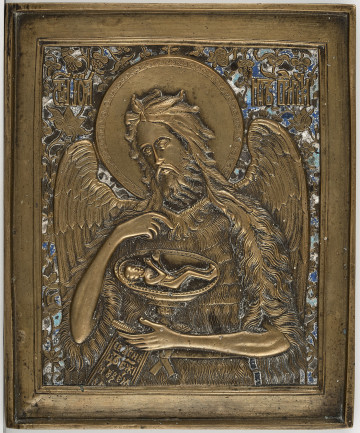
St. John the Baptist
20th century
Castle Museum in Łańcut
Part of the collection: Icons
Mother of God Hodegetria of Tikhvin icon Icons cast from metal alloys, initially imported from Byzantium, enjoyed widespread popularity in Rus. Modelled on Byzantine bronze products, their mass production for cult and domestic use purposes already developed from the 12th c. Initially, they were produced in Kiev and Veliky Novgorod, and since the 13th c. in other centres, usually established by the persecuted in Russia Old Believers, who did not accept the liturgical reform of Patriarch Nikon in the 17th c. The displayed S.12837MŁ, cast in brass and decorated with enamel, shows one of the variants of the Mother of God with baby Jesus - Hodegetria of Tikhvin, whose depiction is very close to the Hodegetria of Smolensk - see S.12677MŁ, S.12777Mł, S.12785MŁ, S.12786MŁ. The difference in the appearance of the baby concerns the position of the legs: in the Smolensk icon, they are positioned in parallel, and in the Tikhvin one, they are crossed, showing the sole of the right foot. The beginnings of the apparition of the Tikhvin Hodegetria in the lands of Rus go back to the 14th c. According to legend, the icon painted by St. Luke, placed in the temple in Blachernae, Constantinople, was supposed to disappear 70 years before the capture of the city by the Ottoman Empire in 1453, to then miraculously appear above Lake Ladoga. Ultimately, in 1383, the painting stayed in Tikhvin, located to the southeast of Ladoga. It was placed in the newly built, wooden Church of the Dormition of the Theotokos. Grand Prince of Moscow, Vasili III funded a brick temple for the icon in the 16th c.; his son Ivan IV the Terrible built a male monastery. The miraculous disappearance of the icon from Constantinople and its appearance in Tikhvin was given a symbolic significance, explaining the loss of the Christian Constantinople as the Second Rome in favour of the Tsardom of Moscow as the Third Rome, which continued the tradition of the Orthodox Church. The icon's further history is described under S.12838MŁ. Teresa Bagińska-Żurawska https://orcid.org/0000-0002-9243-3967
Other names
Tychwińska Mother of God
Dimensions
height: 10.5 cm, width: 7.3 cm
Object type
Icons
Technique
cast, enamelling
Material
brass, varnish enamel
Origin / acquisition method
decyzja administracyjna
Creation time / dating
Creation / finding place
Owner
Castle Museum in Łańcut
Identification number
Location / status

20th century
Castle Museum in Łańcut

19th (?) century
Castle Museum in Łańcut

1800 — 1850
Castle Museum in Łańcut
DISCOVER this TOPIC
National Museum in Lublin
DISCOVER this PATH
Educational path